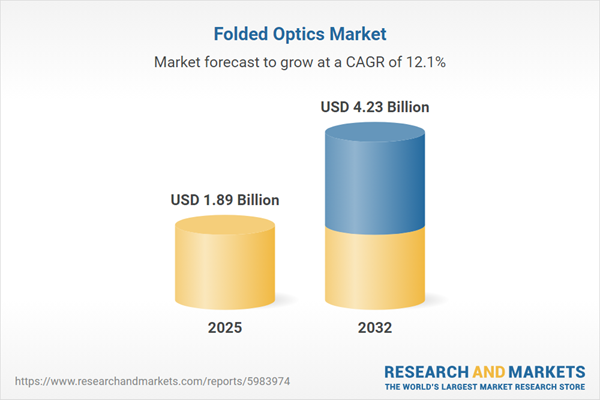Rising Investments in the Expansion of Telecommunications and Data Centers
Speak directly to the analyst to clarify any post sales queries you may have.
The folded optics market is experiencing a paradigm shift as advanced miniaturization and specialized applications broaden global adoption. Senior decision-makers in technology, manufacturing, and procurement require reliable, actionable intelligence to leverage emerging opportunities and navigate new complexities in this fast-evolving sector.
Market Snapshot: Folded Optics Market Size and Growth Trajectory
The Folded Optics Market grew from USD 1.70 billion in 2024 to USD 1.89 billion in 2025. This market is set for robust expansion, maintaining a CAGR of 12.09%, and is projected to reach USD 4.23 billion by 2032. Market growth is propelled by technological convergence across applications, supply chain adaptations, and heightened demand for innovative optical solutions in multiple sectors.
Scope & Segmentation: Comprehensive Coverage of Market Drivers and Trends
This report provides detailed coverage of the folded optics landscape—including market drivers, trends, and competitive positioning. The analysis spans major sub-segments and regions, focusing on the adoption and integration of innovative optical configurations.
- Type: Diffractive Folded Optics, Reflective Folded Optics, Refractive Folded Optics
- Technology: Catadioptric, Grating, Prism, Waveguide
- Material Type: Ceramics, Glass, Plastic
- Application: Automotive, Consumer Electronics (Smartphones, Tablets, Wearables), Defense & Security (Night Vision Goggles, Surveillance Drones), Medical (Diagnostic Imaging, Endoscopes)
- Region: Americas (United States, Canada, Mexico, Brazil, Argentina, Chile, Colombia, Peru), Europe, Middle East & Africa (United Kingdom, Germany, France, Russia, Italy, Spain, Netherlands, Sweden, Poland, Switzerland, United Arab Emirates, Saudi Arabia, Qatar, Turkey, Israel, South Africa, Nigeria, Egypt, Kenya), Asia-Pacific (China, India, Japan, Australia, South Korea, Indonesia, Thailand, Malaysia, Singapore, Taiwan)
- Key Companies: 3M Company, Apple Inc., Asia Optical Co., Inc., Canon Inc., DMF, Inc., FUJIFILM Holdings Corporation, Genius Electronic Optical Co., Ltd., Google LLC by Alphabet Inc., Huawei Technologies Co., Ltd., Kenko Tokina Co., Ltd., Konica Minolta, Inc., Largan Precision Co., Ltd., LG Electronics Inc., MKS Instruments, Inc., Nissei Technology Corporation, Nubia Technology Co., Ltd., OFILM Group Co., Ltd., Oppo Mobile Telecommunications Corp., Ltd., Optikos Corporation, Panasonic Corporation, Qualcomm Incorporated, Ricoh Company, Ltd., RP Optical Lab Ltd., Samsung Electronics Co., Ltd., Sony Group Corporation, Sunny Optical Technology Group Co. Ltd.
Key Takeaways for Strategic Leadership
- Compact design and miniaturization are redefining optical system integration across automotive, electronics, defense, and medical sectors, meeting end-user performance demands without increasing product size or weight.
- Technological advances incorporate nanostructured materials and precision microfabrication, enabling sharper image quality and expanding design versatility for OEMs and device makers.
- Material selection plays a central role in performance, reliability, and cost efficiency; ceramics, glass, and specialized plastics each support distinctive application needs, from thermal stability to scalable production.
- Strategic alliances and cross-industry partnerships are accelerating R&D, supporting rapid prototyping and customization for target markets such as surveillance, AR/VR, and advanced diagnostics.
- Regional manufacturing strengths and regulatory drivers are shaping competitive advantages, encouraging synergies between innovation hubs, production ecosystems, and compliance frameworks.
Assessing the Impact of 2025 Tariff Measures
Implementation of new tariff schedules in 2025 has influenced procurement and supply chain resilience throughout the folded optics industry. Firms are optimizing sourcing by renegotiating contracts, diversifying supplier bases, and integrating local assembly where feasible. In parallel, logistics and legal teams are enhancing customs compliance, seeking classification exemptions, and leveraging bonded warehousing to improve cost stability and ensure operational continuity. These adaptive strategies help organizations maintain supply reliability and competitiveness amid shifting trade policies.
Methodology & Data Sources
This comprehensive market assessment integrates primary interviews with industry experts and corporate executives, alongside secondary analysis of white papers, patent filings, peer-reviewed studies, and regulatory filings. Validation protocols ensure the reliability, accuracy, and strategic relevance of all findings presented.
The Folded Optics Market: Why This Report Matters
- Empowers decision-makers with practical insights to inform procurement, R&D, and innovation investments across complex value chains.
- Equips leaders with an integrated analytical framework to evaluate risk management, regulatory impacts, and emerging market opportunities.
- Facilitates data-driven planning by synthesizing proven technical trends, strategic segmentation, and actionable recommendations targeting real-world business challenges.
Conclusion
As the folded optics market enters a growth-oriented phase, investing in materials, collaboration, and supply agility remains critical. Organizations leveraging these insights and strategies will be well-positioned for sustained success in this dynamic technology landscape.
Additional Product Information:
- Purchase of this report includes 1 year online access with quarterly updates.
- This report can be updated on request. Please contact our Customer Experience team using the Ask a Question widget on our website.
Table of Contents
3. Executive Summary
4. Market Overview
7. Cumulative Impact of Artificial Intelligence 2025
Companies Mentioned
The companies profiled in this Folded Optics market report include:- 3M Company
- Apple Inc.
- Asia Optical Co., Inc.
- Canon Inc.
- DMF, Inc.
- FUJIFILM Holdings Corporation
- Genius Electronic Optical Co., Ltd.
- Google LLC by Alphabet Inc.
- Huawei Technologies Co., Ltd.
- Kenko Tokina Co., Ltd.
- Konica Minolta, Inc.
- Largan Precision Co., Ltd.
- LG Electronics Inc.
- MKS Instruments, Inc.
- Nissei Technology Corporation
- Nubia Technology Co., Ltd.
- OFILM Group Co., Ltd.
- Oppo Mobile Telecommunications Corp., Ltd.
- Optikos Corporation
- Panasonic Corporation
- Qualcomm Incorporated
- Ricoh Company, Ltd.
- RP Optical Lab Ltd.
- Samsung Electronics Co., Ltd.
- Sony Group Corporation
- Sunny Optical Technology Group Co. Ltd.
Table Information
| Report Attribute | Details |
|---|---|
| No. of Pages | 186 |
| Published | November 2025 |
| Forecast Period | 2025 - 2032 |
| Estimated Market Value ( USD | $ 1.89 Billion |
| Forecasted Market Value ( USD | $ 4.23 Billion |
| Compound Annual Growth Rate | 12.0% |
| Regions Covered | Global |
| No. of Companies Mentioned | 27 |









